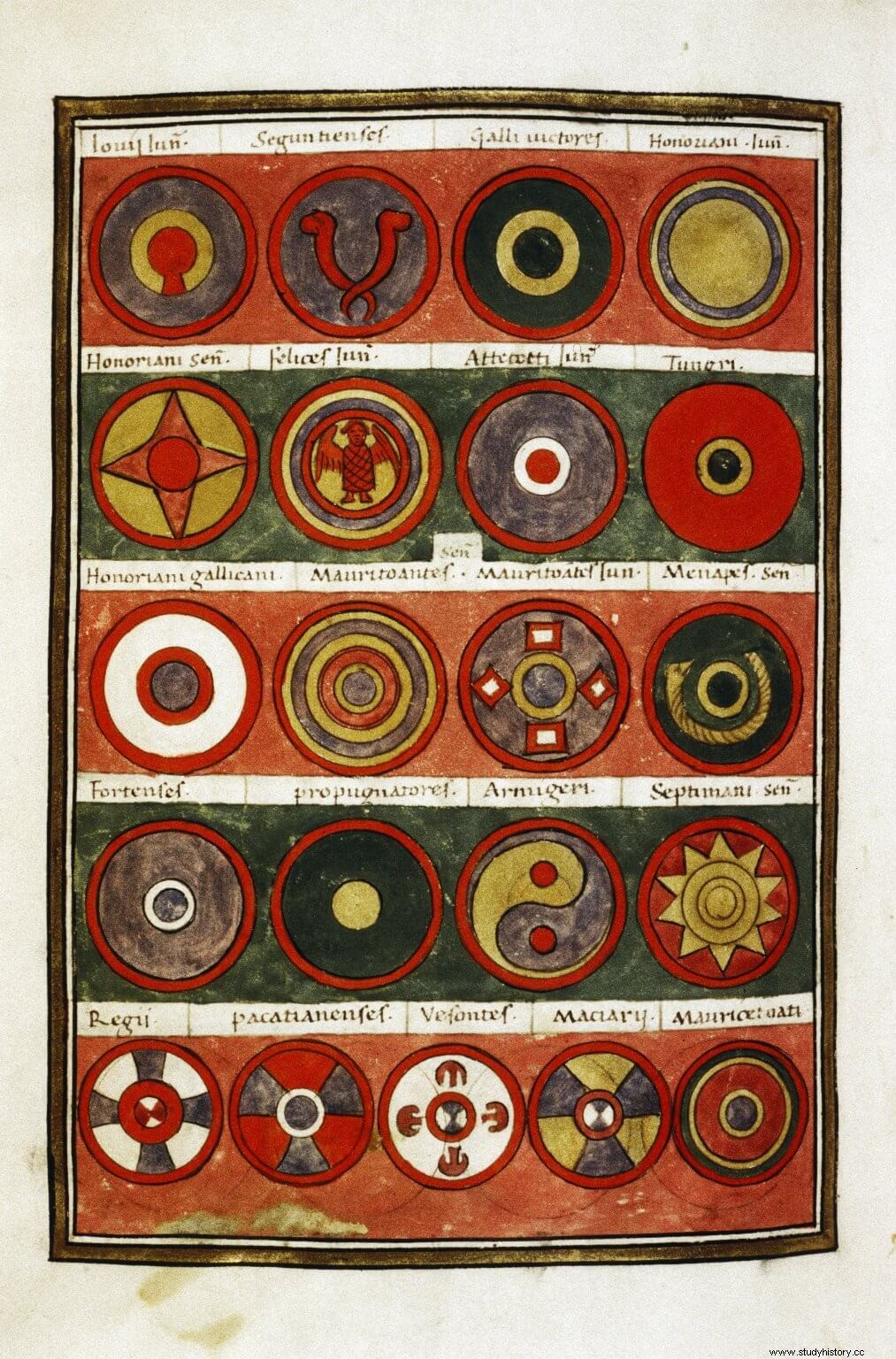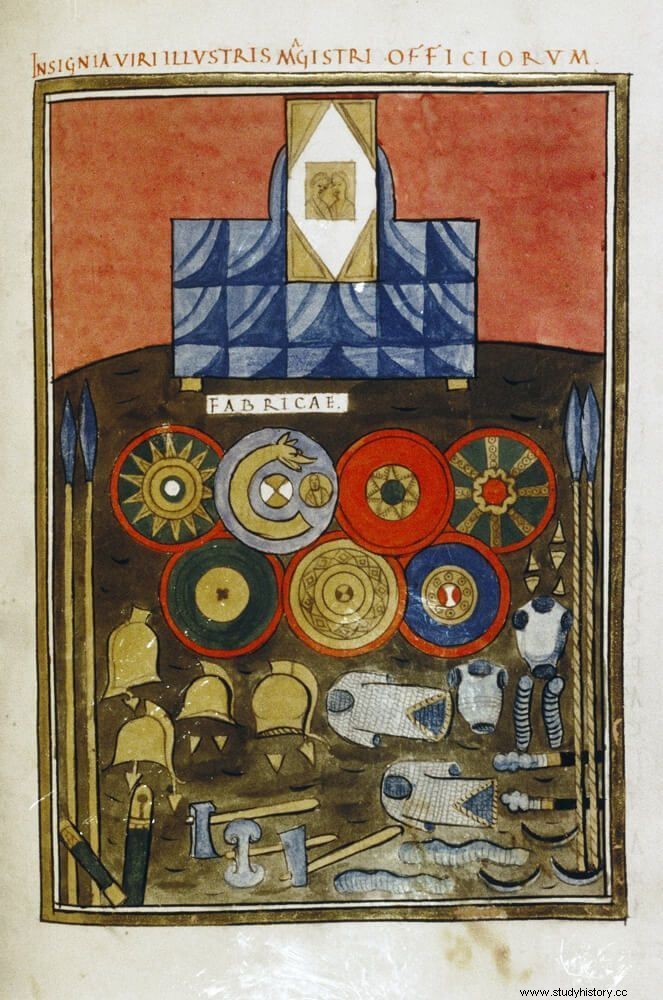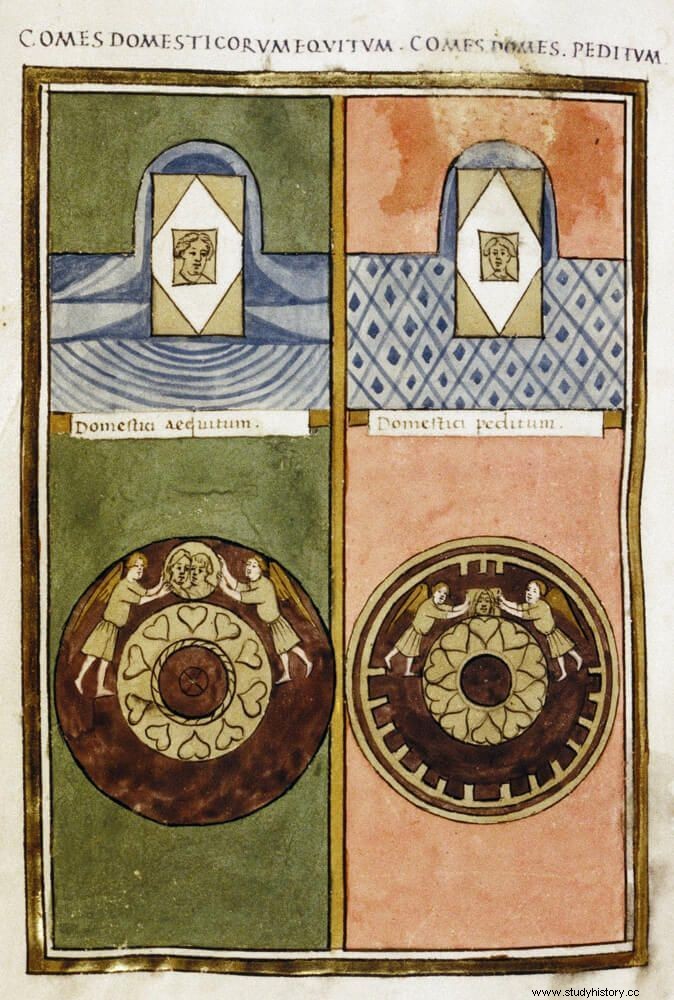
A document of these characteristics, therefore, does not It could not be limited to a single moment, but it had to evolve along with events. The first draft is located around the year 394 or 395 and would be the official basis for future updates, which were happening without regularity until the year 425 or 429. The first phase of the update occurred between 401 and 408, during the time when Stilicon dominated the court of the West, with adjacent and unconnected elements, trying to know above all the military reality of the Roman Empire of the West in a tremendously convulsive moment. The other update phase of the Notitia Dignitatum It was between 425 and 429 and was intended to cover the thirty-five years that had passed since the first draft, but it ended up being more of a poor element of political propaganda that tried to show, despite its non-existence, a strong army supported by a efficient public administration.
The Notitia Dignitatum It is a document with great lights and shadows, since it is the only contemporary source to know in detail the structure of the Roman army of the 5th century, the one that experienced the transformation of the military machinery of the 4th century established by Diocletian and Constantine towards the Byzantine army of Justinian . Among its lights we can find important data on the number of detachments and their distribution, on the internal structure of the army itself and the hierarchy of the different units. But among its shadows we find that at the same time it is theoretical information, which usually differs from practice, which does not report the numbers of each unit or the thickness of the expeditionary armies and that we cannot faithfully contrast due to the lack of sources. reliable or sufficiently detailed.
The Roman army of the Late Empire was classified, according to the Notitia Dignitatum , very similar to the Roman army of the second half of the fourth century used by Julian :the limitanei , also sometimes called ripenses if they were quartered next to river borders, that they were the troops in charge of defending the border and that at the same time that they defended it, they dedicated themselves to cultivating the lands that had been assigned to them; the comitatenses , which formed the core of the Imperial field armies and had superior training and weaponry; the units of palatini , regiments of the field armies that were part of their elite and accompanied the emperor; and finally the scholae , which were the Imperial Guard (five in the West and seven in the East) and unlike all the others, they were commanded directly by the emperor through the magister officiorum , a civil magistrate.

Limitanei and comitatenses are names that designate the ascription of a unit to a garrison or field army, and both the legions and the auxiliary units or the vexilationes of cavalry were ascribed to one or another type. Specifically the armies of comitatenses they were formed by legions, of about 1000 men each; vexilationes or cavalry detachments of up to 500 soldiers; and auxiliary units of about 500 warriors each. Both the legions and the auxiliaries of the comitatenses could be considered palatini . The armies of limitanei they had a more confused organization and with greater variation according to their geographical location, although broadly speaking we find the legions, of 1000 warriors as well; auxiliaries, 500 men; and some cavalry squadrons that went by different names, such as cunei equitum , alae or simply equites , which did not exceed 100 soldiers. The scholae , meanwhile, should be around 500 members each. The number of members of each detachment does not appear in the Notitia but rather are estimates made a posteriori based on the information that contemporary historians gave on the number of units and participants in the expeditionary armies, such as Orosio and Procopio.
Based on this information, it is interesting to see how the Notitia Dignitatum shows some relevant data regarding the number of military forces of the Lower Empire. Specifically, the whole of the army of both parties could add according to the Notitia Dignitatum 360,000 troops within their armies limitanei (249,500 infantry and 110,500 cavalry) and 194,500 within their comitatenses armies (145,000 infantry and 46,500 cavalry) if each regiment had the number of members per unit described above. The forces of the entire Roman world reached the approximate amount of 554,500 soldiers, who remained distributed more or less equally between both halves.
The Notitia Dignitatum , however, not only provides numerical information regarding the composition of the Roman army, but its study also reveals in part what happened to the 5th century army. For example, one of the latest updates (421) reports that the The Western army was made up of a total of 181 regiments comitatenses , but of them 97 had been created after the year 395, which indicates brutal human losses in those 30 years. The worst part of these losses was suffered by the army of the Rhine, since between 395 and 421 it lost more than half of its troops (37 of its 58 units were created during the reign of Honorius) due to its participation and defeat. during the usurpation of Constantine III and his fight against the invaders of the Rhine on Christmas in the year 406.

On how the terrible losses suffered by the army of the late Roman Empire also offers us valuable information the Notitia Dignitatum . Of the 97 new regiments comitatenses created between 395 and 421, 62 of them were actually former garrison forces reconverted to complete field armies. What took place, in fact, was a transfer of "quality" between the field armies and the garrison armies:while some limitanei units 28 pseudocomitatenses legions were transferred to the field armies (units limitanei assigned to armies of comitatenses ), another 14 legions comitatenses , and 20 vexilationes comitatenses cavalry were placed within the garrison armies. With all this, the number of regiments comitatenses , the true core of the Roman forces, had been reduced by 25% in the field armies. In this process the Army of the Rhine was, again, the one that suffered the most, since of its 58 regiments at least 51 were converted into garrison troops.
However, the evolution of the Roman army in the West in the 5th century did not stop there, since 35 of the new regiments with the highest status (comitatenses and palatini ) bore names corresponding to Germanic tribes (Marcomans, Brisigaves, etc.), which offers a reasonable doubt to consider that they could be composed, at least originally, by a majority of non-Romans.
So the seemingly boring list that is the Notitia Dignitatum shows us through his study the problems and the crisis that the army of the Lower Empire faced and that brought down the most important generals of the time, such as Stilicho or Flavius Constantius, despite their successes.
Bibliography
Heather, P. (2006):The Fall of the Roman Empire . Barcelona:Critical Editorial
Neira Faleiro, C. (2006):The “Notitia Dignitatum”:new critical edition and historical commentary . Madrid:Higher Council for Scientific Research.
Southern, P. and Dixon, K. (2018):The Roman Army of the Later Empire . Madrid:Awake Ferro Editions.
